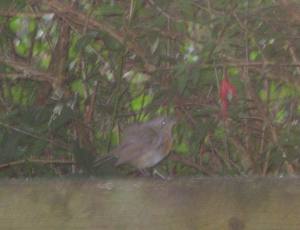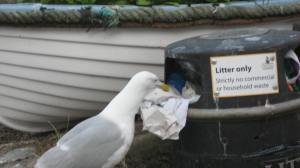At the crack of dawn, one of the seagulls tells a joke. Immediately others nearby throw
back their heads and laugh raucously. This hysteria soon spreads until the whole community are engaged in a cacophony of merriment. It is not clear whether more jokes are then shared, but certainly the hilarity lasts all morning. The seagulls, of which there are many, appear to have a very light hearted view of life altogether. They leave their seagull babies, all fluffy with soft grey feathers, perched in the most unlikely places while they go off to join in the banter. You can see these babies sitting quietly on grey slate roofs, hardly detectable to the eye, until one of them moves. You can find them squatting down back alleyways looking weak and vulnerable, though they would probably have your eye out if you approached them. Seagull babies can’t fly when they first leave the nest, so they just have to amuse themselves while they wait for their parents to come back from the party.
As soon as we arrived at our cottage in the country, I started putting food out for the birds. I was interested to see what type of exotic creatures lived out here in the wilds of Polperro. There were a number of overhanging trees at the side of the garden and I could hear the tantalising sound of birds moving through the undergrowth. The familiar peep peep of the robin was always present, but try as I might, I could not catch a glimpse of one. I thought I saw a blackbird fly across checking out the seed I put on the top of the compost bin, but I couldn’t be sure. A day or two later I sat out in the garden, camouflaging myself behind the washing hanging on the line. The food had been disappearing and I was determined to see who had been taking it. Sitting still as a rock I was finally rewarded by the sight of an anaemic looking robin who came to join me. He rustled up through the lower branches of the shrubbery, drawing my attention, before sitting close by on the fence. His chest was daubed with red, like the colour had run in the wash, but he had the distinctive robin tail wag as he moved. We sat there for some time looking at each other until he lost interest and flew away. Over the week he became a more confident visitor and would take food from the top of the bin without even a sideways glance in my direction. All the other robins kept away, preferring to watch from the branches until the coast was clear.
We had a crane fly in our bedroom. He seemed to be inspecting the ceiling as he covered every square inch of it on his long, sticky legs. I hadn’t seen a crane fly for years, though the ‘daddy-long-legs’ as we used to call them were a familiar part of childhood. The crane fly larva is called a leather jacket and I can remember seeing them in the long grass of our back garden. They look like a cross between a caterpillar and a small, fat worm. Not sure why they are called leather jackets as they look naked and vulnerable, not protected by thick leather skin at all. The starlings would descend on mass down to our lawn and spend many a happy hour rummaging for these tasty delights. There are no crane flies at home and so no leather jackets either. A whole generation of starlings are missing out on a treat.
There was a spider in the front room. I was hoping that no-one had noticed it or it would have been banished to the garden, or worse. You can tell that I am struggling to find creatures worthy of a mention and indeed my visit to the countryside confirmed my belief that you don’t have to live in the country to enjoy wildlife. In fact if you want to get close up and personal then buy yourself a city pad. In urban environments we are all forced to share the same space, humans and wildlife alike, while out here in the country there are so many natural habitats they keep a low profile. In the comments book belonging to the cottage, there were mentions of bats emerging at dusk, a familiar owl serenading in the twilight and sightings of deer across the valley. The wildlife was there alright, but I saw none of it.
The bird food did eventually tempt the blackbird into the garden; though he was very reluctant to take any seeds while I was pointing my camera at him. There were others who flew through so quickly I couldn’t catch sight of them. It felt as though they were teasing me. Even the butterflies were elusive with their ‘now you see me, now you don’t’ flutter that made it impossible to photograph them.
So the seagulls became my one distraction. On a visit to Looe where we went out on a glass bottomed boat and saw nothing but the sandy bottom of the bay, I witnessed two seagulls having an altercation. One was pulling the other down a slanted roof by the wing; pulling it away from another who was perched on the apex complaining loudly. A fourth seagull was standing by watching the whole thing. Well you always need someone to hold the coats. There was quite a tussle for a while, which I watched with interest from the car park, then they all threw back their heads and laughed. It had just been a huge joke after all.
Not to say that the seagulls didn’t have some sense of civic responsibility. One chap in our local village put himself in charge of recycling and was disappointed to find that people had been putting the wrong rubbish into the bin. He had to empty it all out to check, but seemed pretty lax on what to do next. Another took it upon himself to carry out neighbourhood watch. He spent some time peering into everybody’s windows and tapping on them if he felt the need to intervene.
We didn’t really see any exotic birds of Cornwall until we visited the lost gardens of Heligan. A hide had been built and the birds were encouraged to visit by regular top ups of tasty seed. In just a few short minutes we saw chaffinch, greenfinch, a variety of tits, sparrows, robins and even a woodpecker. I knew they were there all the time. These country birds were just having a laugh.










Seagulls make me laugh. They are definitely a funny bunch except when they want your food. Then they are maniacs!
LikeLike
The seagulls were the most interesting part of the stay. They don’t really want to live in the towns but their habitat is getting lost, so just like the rest of us, they make the best of it. The one in the rubbish bin was really funny. Took his work very seriously.
LikeLike
We live on the edge of the country and when I first moved in with my partner saw the odd blackbird and sparrow, but that was all. Now, after regular feeding we have just had the best spring/summer period of all. Chaffinch, greenfinch, goldfinch, great tit, coal tit, blue tit, starlings, blackbirds, robins and sparrows all feeding young. Keep up the feeding, the birds will soon learn and you will be rewarded.
LikeLike
I’m sure you are right Iain. It takes time. I knew they were there but I just couldn’t see them. Very frustrating. We were only on holiday for a week and I don’t suppose the feeding continued after that. I’m trying to encourage the smaller birds into the garden at home. Difficult with the pigeons taking over the place. Any tips? You will hear more about my ‘small bird project’ soon. Thanks for reading.
LikeLike
The Lost Garden’s of Heligan sound beautiful Della I did not hear of them when I lived in England. Sounds intriguing glad you had a nice stay in the country, but like you say wildlife is everywhere, you just have to be observant.
LikeLike
Hi Kath. The lost gardens of Heligan are very interesting. It was an old Edwardian estate that had been abandoned after the first world war. Nature reclaimed the space and it became overgrown – hence lost. It has since been restored and gives an idea of the splendour of that age, if you had the money. I agree, wildlife is everywhere, trying to keep out of our way!
LikeLike